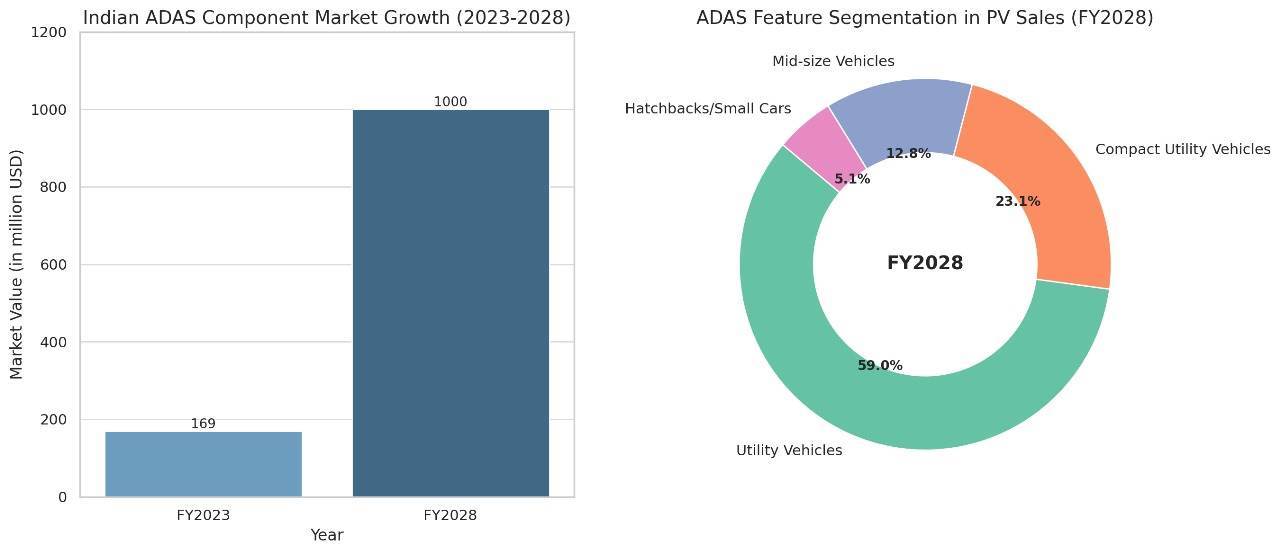While the impact of the EV revolution on the Indian automotive components landscape has been much talked about, there is a similar transformation taking place due to the emergence of another technological trend — Advanced Driver Assistance Systems or ADAS. According to a new report from Rubix Data Sciences, this technological evolution has created a market poised for explosive growth over the next five years.
Advanced Driver Assistance Systems (ADAS) are technologies designed to improve vehicle safety and enhance driving convenience by providing automated support to drivers. These systems use sensors, cameras, radar, and Lidar to monitor the vehicle’s surroundings and provide real-time data for decision-making. Key features of ADAS include adaptive cruise control, lane-keeping assist, automatic emergency braking, blind-spot detection, and parking assistance. They are becoming increasingly common across various vehicle segments and markets, with India being no exception.
Market Growth and Projections
According to industry analysis from CRISIL Market Intelligence and Analytics cited in the report, the Indian ADAS component market, valued at approximately USD 169 million in FY2023, is projected to reach around USD 1 billion by FY2028 – a sixfold increase. The report reveals that currently, passenger vehicles featuring ADAS account for nearly 2% of total PV sales in FY2023.

By FY2028, the market segmentation will be clearly defined. The Rubix report projects that utility vehicles will dominate, accounting for 55% to 60% of PVs sold with ADAS features, followed by compact utility vehicles at 20% to 25%, mid-size vehicles at 10% to 15%, and hatchbacks or small cars comprising the remaining 3% to 7%.
Technological Integration and Industry Impact
The report outlines how ADAS features are fundamentally reshaping the auto components industry through their reliance on sophisticated safety and convenience technologies. As directly quoted in the report: “The rise of Advanced Driver Assistance Systems (ADAS) is fundamentally reshaping the Indian auto components industry by driving the demand for sophisticated safety and convenience technologies.”
The transformation encompasses various ADAS features, including “adaptive cruise control, lane-keeping assist, and automatic emergency braking.” These systems rely on “a complex ecosystem of high-tech components, including sensors, cameras, radar, and Lidar systems, that work in unison to deliver real-time data and enable vehicles to respond automatically to potential hazards.”
Global Context and Indian Adoption
The report places this transformation in a global context, noting that “ADAS has been widely adopted globally, with the US, China, and Europe leading the way in technological advancements.” In India, while adoption is still in early stages, the momentum is building, as evidenced by the current 2% market penetration in passenger vehicles.
Future Outlook
Looking ahead, the Rubix report indicates that the trend reflects the automotive industry’s broader commitment to developing smarter, more connected vehicles. The report emphasizes that as vehicles become increasingly autonomous and connected, the demand for sophisticated ADAS components will continue to grow, presenting both opportunities and challenges for India’s auto component manufacturers.
This technological shift represents more than just an upgrade in vehicle safety systems – it marks a fundamental evolution in how India’s auto component industry approaches manufacturing and innovation. As the report concludes, this transformation through ADAS technology will play a vital role in shaping the future of India’s automotive sector, positioning the country as an important player in the global automotive technology landscape.
The report’s detailed analysis suggests that ADAS technology will be a key driver of growth and innovation in India’s auto component sector, pushing manufacturers to develop new capabilities and adapt to changing market demands. This transition represents both a challenge and an opportunity for India’s automotive industry as it seeks to establish itself as a global hub for advanced automotive technology.
ADAS in India
The take-up for ADAS technologies remains to be seen in a cost-sensitive market such as India. Moreover, given the diverse road infrastructure and varying traffic patterns, it is crucial for ADAS technologies to be optimised for Indian environments. This could include enhancing sensor and camera systems to better handle issues like poor road conditions, heavy congestion, and irregular traffic behavior, which are common in many areas.
Additionally, integrating ADAS with local mapping systems and real-time traffic data could further improve its effectiveness, enabling features like adaptive cruise control and lane-keeping assist to function more accurately in busy urban areas. Manufacturers may also need to focus on affordability to ensure that ADAS features are accessible across a broader range of vehicle segments, from economy to premium models.
As vehicle sales increase, educating drivers on the use of ADAS features and their limitations will be important. Regulatory support and clear standards for ADAS performance could help drive adoption and ensure that the technology aligns with safety goals.
